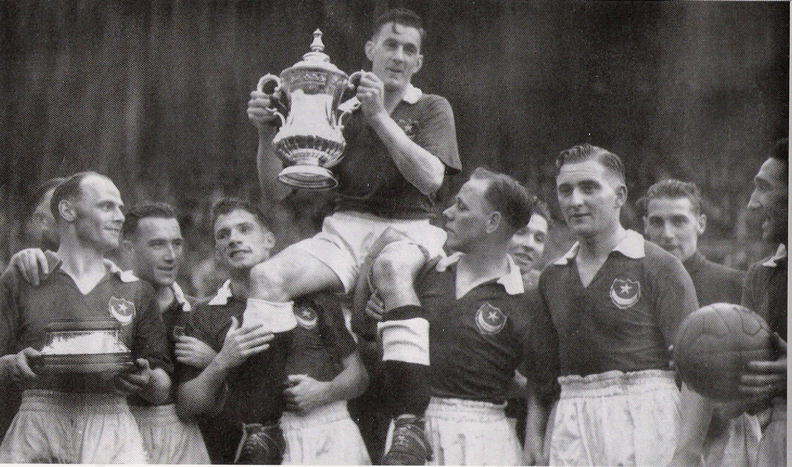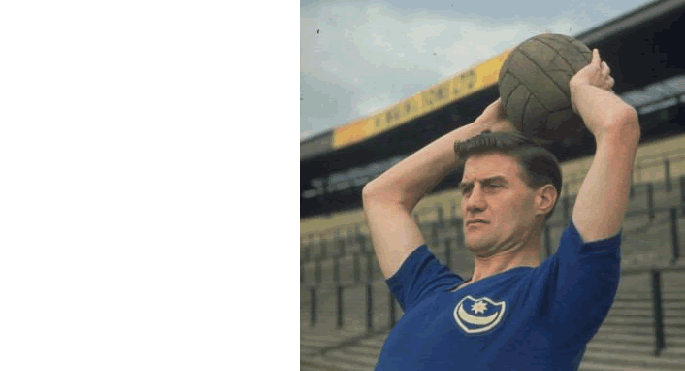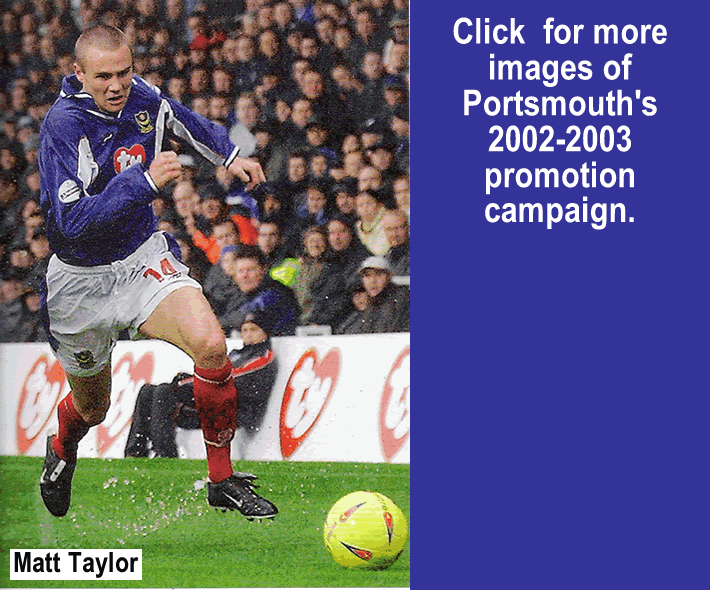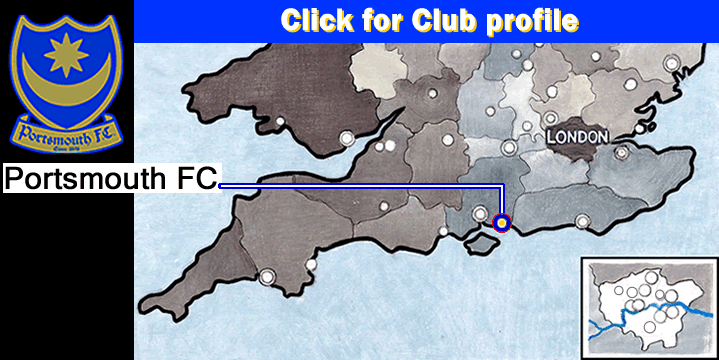…
…
Portsmouth FC was formed in 1898, from the ashes of the Royal Artillery Football Cub, which was forced to disband due to breach of its amateur status. PFC began play in September, 1899, in the Southern league. For their first decade they wore pink jerseys with maroon trim, and were known as ”the Shrimps,” though the name “Pompey” has been associated with them from the beginning. {for origin of the name Pompey, see # 10 on this list} In 1911, dissolution was averted by a new board, with guarantees to the banks for debts. After the war (1920), the League expanded, and Portsmouth joined the new Third Division. Four seasons later, in 1924, the club gained promotion to the Second Division. They made it to the First Division, for the first time, in 1927. They did this by the slenderest of margins, a goal average only .005% higher than Manchester City. Jack Tinn became manager that same year . He would remain until 1947, and is credited for building the side that eventually won the Title (in 1949). Portsmouth initially had to stave off relegation , though, with two successive 20th place finishes. However, they did well enough in the FA Cup to make it to the final in 1929, losing to Bolton Wanderers 2-0, at Wembley. Portsmouth began to secure their foothold in the top flight, finishing as high as 4th place (in 1931), and reached the top ten 6 times in 9 seasons (1931-39). In 1934, another good Cup run ended with the club losing to Manchester City, 2-1, in the Final. Pompey finally won the FA Cup in 1939, beating heavily favored Wolverhampton 4-1. Goals were scored by ex-Wolves player Bert Barlow (twice), Jock Anderson, and Cliff Parker.

{Pictured above, the 1939 FA Cup winners.}
From the Guardian.co.uk… British Pathé archive: Portsmouth win the 1939 FA Cup.
War broke out soon after, and Portsmouth ended up holding the Cup until 1946, when the competition was finally resumed. Portsmouth’s status as one of the nation’s chief naval centers meant an influx of investment and talent to the area during World War II. In 1947, in recognition of the city’s association with the military, Pompey began wearing their distinctive red stockings (blue for navy, red for army). After the war, the club improved from 12th (1947), to 8th (1948). And in 1949, under manager Bob Jackson, Portsmouth won their first League Title. The squad played an attacking style of football, and featured midfield anchor Jimmy Dickinson, bustling left-winger Jack Froggatt, fleet right winger Peter Harris, and prolific forward Duggie Reid {see this article}. The club also reached their peak attendance that season, averaging 37,082. In 1950, Pompey repeated as champions, beating Aston Villa 5-1, on the final day. This allowed them to finish 2/5ths of a goal higher than Wolverhampton, for the Title.
{Below is Jimmy Dickinson, who holds the all-time appearance record for Portsmouth FC, with 764 games played (1946-65), as well as 48 caps for England.}

As the 1950′s wore on, the club failed to replace their aging veterans, and Portsmouth’s decline began. {here is Peter Harris, ca.1953} Though they finished 3rd in 1954, by 1959 they were relegated. And in 1961, it was back to the Third Division, with a second relegation in 3 years. Portsmouth bounced back to the 2nd tier the next season, though. There they remained for 13 seasons, with a forgettable average finish of 15th place. A financial crisis in 1976 forced the club to sell off their best players. The predictable result was relegation, to the 3rd Division, in 1976, and down to the 4th Division, in 1978. Pompey began the climb back up, by returning to the third tier in 1980, and the second tier in 1983.
Portsmouth made it back to the top flight in 1987, under manager Alan Ball, but for just one season. Back in the second level, the club spent 14 seasons barely treading water, with an average finish of 16th place. On six occasions, they had to struggle to avoid relegation, most notably in 1998, when returning manager Alan Ball helped the club avoid the drop. By this time, Portsmouth had became known as “the Sleeping Giant” of the south coast. The one real highlight of the decade was a good FA Cup run in 1991-92, with Pompey losing to eventual Cup winner Liverpool, in the semi-finals. In their centenary season of 1998-99, Portsmouth went into financial crisis. Competing factions could not raise sufficient capital, and the off-field battle over control of the club affected on-field results. The club was under threat of dissolution in their 100th year. In December, 1998, Portsmouth went into financial administration. In May, 1999, the club was rescued by Serbian-American Milan Mandaric. Before owning the San Jose Earthquakes, of the North American Soccer League, Mandaric had made his fortune in Silicon Valley, as a manufacturer of computer components. After the NASL’s demise, Mandaric returned to Europe, first as owner of Standard Liege (Belgum), and then OGC Nice (France). Out of the blue, Mandaric took on the task of bringing Portmouth FC out of administration, and began investing heavily in the club. He was attracted to the English game by the passion of the fans, something he found lacking in Belgium and the south of France.
There was another relegation scare in 2001, when Graham Rix was manager. A final-day victory, coupled with a Huddersfield loss, kept them up. Mandaric hired Harry Redknapp as director of Football that summer, after he left West Ham (where he had managed for 6 seasons). The inevitable happened the following spring, as Rix was out, and Redknapp in, as manager. During the summer of 2002, Redknapp embarked on a flurry of transfer activity. Svetoslav Todorov, an unknown Bulgarian striker, was bought from West Ham. People wondered why, but stopped wondering after he ended up leading the second tier in scoring the next season, with 26 goals. He sold Portsmouth’s most valuable asset to raise cash. This was beanpole striker Peter Crouch (who now plays for Liverpool, and England), dealt to Aston Villa, for 5 million pounds. He unearthed gems in young left back Matt Taylor, whom he prised from Luton Town for a mere .75 million pounds; and solid center back Arjan De Zeeuw, on a free transfer from Wigan. Then he made the key signing of veteran midfield general Paul Merson, from Aston Villa. Merson was faced with the prospect of spending the season on the bench at Villa. He knew Redknapp was putting together something special on the south coast, and joined. There were more brought in, most prominent being crafty midfieder Steve Stone, also from Aston Villa. And the wily Redknapp wrangled deals that had Villa paying around half of Merson and Stone’s wages. Portsmouth shot out of the gate, and never looked back. The transformation in the club was astounding. Merson captained a squad that simply dominated the league. The club began scoring at a prolific rate, and ended with 97 goals. They won the division by 6 points, and were promoted, along with Leicester City, and Wolverhampton.

Back in the promised land of the English Premier League, Pompey started out very good, but by January, 2004, they were in the relegation zone. Young striker Ayegbeni Yakubu began to find his stride, though, and his goals helped propel Portsmouth to a strong finish: 13th place. The next season started promising, but rumours began of a rift between Redknapp and Mandaric. The problem was exacerbated when Mandaric hired the Croatian Velimir Zajec as Executive Director. Redknapp bristled at this affront to his status, resenting the fact that there would be someone else, besides the owner, that he would have to answer to. So he stepped down, in October, 2004, when Portsmouth was sitting in 10th place in the table. Zajec, and assistant coach Joe Jordan co-managed the club, until Frenchman Alain Perrin was hired, in February, 2005. Meanwhile, Redknapp angered Pompey fans by becoming manager of hated rivals Southampton. Both clubs became involved in the relegation battle. Pompey clinched safety on the second-from-last game; Southampton went down.
The next season, defensive lynchpin De Zeeuw left, returning to Wigan. It surfaced that he disliked Perrin (he wasn’t the only one). Zajec’s additions to the squad were by and large underwhelming, and Pompey sat bottom of the Premier League all though the fall of 2005. Perrin was sacked in November. And in December, the prodigal son returned: Redknapp resigned from Southampton, and was re-hired by Mandaric. The club faced an uphill battle, but was helped by a cash infusion from Alexandre Gaydamak, who became co-owner of the club. Three acquisitions from Tottenham proved crucial. Sean Davis, Pedro Mendes, and Noe Pamarot strengthened the midfield and defense. Mendes’ last second 30-yard strike against Manchester City, in March, 2006, was the impetus for Pompey’s miracle escape from relegation. They had sat 9 points below safety, with 10 games remaining, but survived.
That summer, there was a buzz around Pompey similar to the summer of 2003. Good players started to want to be part of what Harry was doing, like goalkeeper David James, who put in a transfer request at Man City. And Redknapp landed quality England international, and Arsenal ex-captain, Sol Campbell. The 2006-07 season saw Portsmouth playing less reckless, and more defensively sound. They were in the top 4 up until the Holiday season, ultimately finishing in 9th place, only 2 points shy of qualifying for Europe. Mandaric sold his half-share to Gaydamak, saying his work was done. He has since bought Leicester City, a club similar to Portsmouth, in a sleeping-giant sort of way. Portsmouth currently sits 6th in the table. Pompey has gone from the brink of liquidation, to the upper echelon of the Premier League, knocking on Europe’s door, in nine years.
Thanks to these sites: The 5 kits on the lower left, on the chart: copyright Historical Football Kits, reproduced by kind permission. (historicalfootballkits[dot]co[dot]uk). The 3 sets of newer kits: Colours Of Football (colours-of-football[dot]com), Some People Are on The Pitch (spaotp[dot]com). Photos: The Stadium Guide (stadiumguide[dot]com), (blogs[dot]warwick[dot]ac[dot]uk), (cache[dot]viewimages[dot]com), Pompey Web (pompeyweb[dot]co[dot]uk).
Special thanks to Pat Symes, who wrote “Sleepimg Giant Awakes,” published by the Parrs Wood Press (parrswoodpress[dot]com), and Mike Walker, whose great photos comprised the Portsmouth promotion run gallery here.

